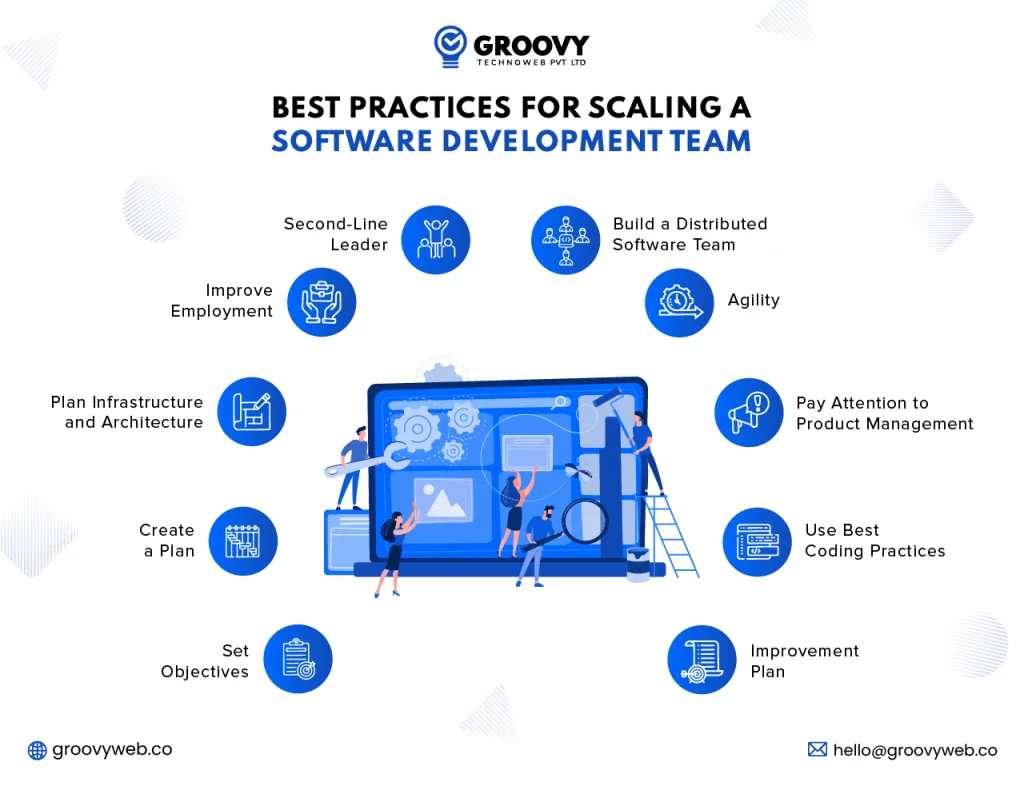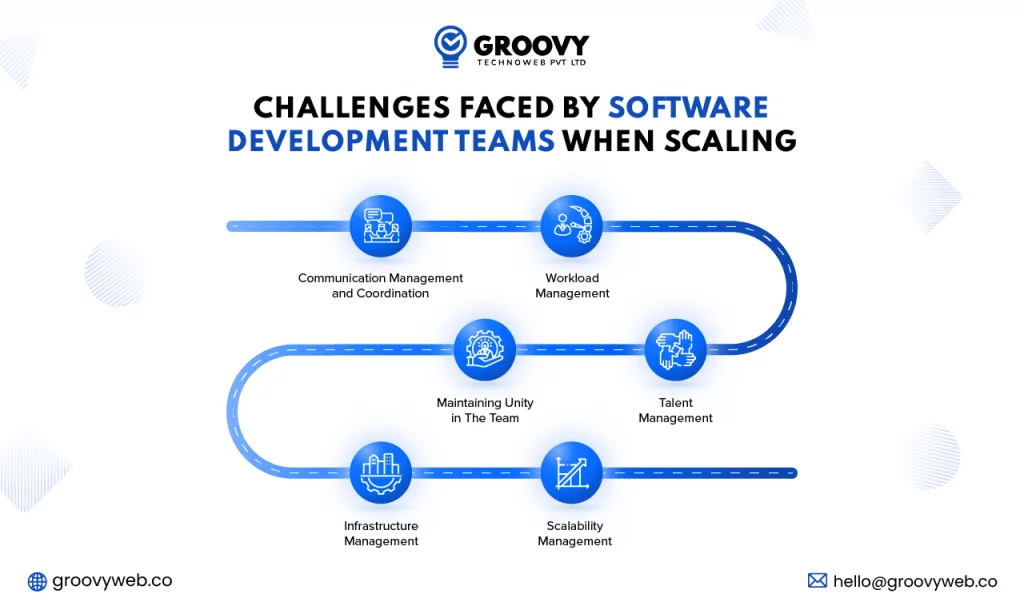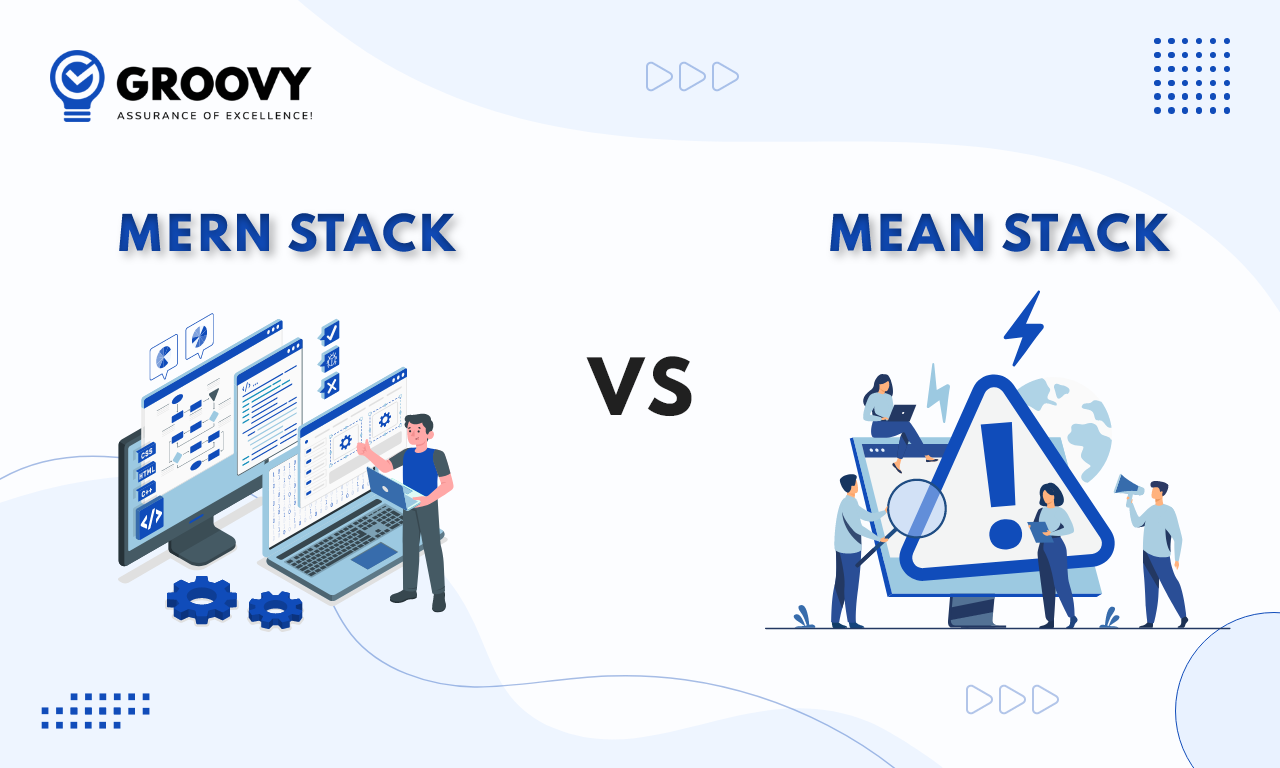The Road to Growth: Guide to Scaling Your Software Development Team
Rahul Motwani
March 31, 2023 474 Views
Quick Summary : The Road to Growth: Guide to Scaling Your Software Development Team is a comprehensive guide that offers expert advice and insights on how to scale a software development team successfully. The guide covers various topics, including hiring and onboarding, team structure and communication, project management, and strategies for promoting growth and success.
Scaling is one of the important steps in the development of a startup or small company. With an expanded team and established departments, we expect more performance. Scaling up a software development team brings as much challenge as an opportunity, even with well-defined processes, expertise, and detailed development strategies. It tends to lose performance instead of increasing acceleration. This post will help to scaling your software development team with valuable tips and best practices.
What actual is Software Development? Process of Software Development
The software development process is the process of dividing software development tasks into smaller, parallel, or sequential steps or sub-processes to improve product design and management in software engineering so it is also known as the software development life cycle (SDLC).

#1 . Requirements collection and analysis
Before you can create team of software technicians can come up with a general idea of any software, they need to gather their business needs at this early stage. There are several questions to ask at this stage, including:
- Who should use this software?
- How will the software be used once completed?
- What kind of data should be added to the software?
- What should be the data exported from this software?
When answering these general questions, a general outline will be created for developers to focus on. This data is then analyzed to ensure its accuracy and the possibility of merging the same data. Finally, the eligibility requirements are documented to guide the next level of software development steps.
#2. Design
At this stage, a draft design is prepared for the software from Stage 1 specification requirements. The system design helps to identify hardware and system requirements. It also helps to define the overall system in the software architecture. The main design specification for the system serves as input for the following steps of the software development model. At this stage, a testing strategy is developed by the testers that outline what to test and how to verify it.
#3. Encoding / Implementation
Once you have received the design documentation for the software to be built. Tasks after the design phase are divided into equal units and modules. This is where the actual coding begins. The main focus of this phase is to perfect code by developers. This specific step is the longest of all protocols.
#4. Tests
If you want to know what software development is you can’t skip testing. This step is very important for developers. If anything goes wrong in the testing phase or an error is found in the code. This may lead to a re-encryption process, and the cycle continues until the same step is completed. At this stage, various functional tests, such as integration testing, unit testing, system testing, acceptance testing, and non-functional test, have been completed.
#5. Deployment
After errors have been removed during the testing phase, the next step is known as the deployment step. The finalized code is used in the software. Then deploy or deliver to customers for use.
Because they are delivering products to potential customers, the first thing to do to ensure it works well at a large scale is beta testing. If there is any possibility of any changes or defects that may occur during use, the system instantly reports to the team to fix errors so they work well in real-time. Once the change has been made with all the bugs fixed, the final distribution or deployment will begin.
#6. Maintenance
When customers started using well-developed software, Actual problems began to appear over time. However, it may take occasional problems to occur again and again. This specific process is known as final product or software maintenance.
Describe Statistics of Software Developer’s Salary (globally)
Even if business owners are quite tech-savvy, building, scaling, and maintaining a product alone can be exhausting sooner or later, you will want to think about hiring developers for your team. We will take a closer look at average developer salaries around the world.
Factors Influencing the Average Salary of Software Developers
When it comes to software developer salaries, the salary gap changes depending on a number of factors, On the one hand, a senior developer in Silicon Valley can charge you up to $13,800 per month. On the other hand, you can find a young developer from Mexico and pay them $2,000. That’s enough.
To better understand the specifics of the global technology labor market, Lets look at the factors that determine the value of tech teams.
- Specialization:
Software engineering is a broad field. That covers so many technologies that you can create different types of products. Typically, the average salary of hiring software developers depends on their core skills and expertise. The cost of hiring a developer that varies based on the skill set and the primary job the engineer handles.
- Experience:
Experience is another factor that determines developer value. Here are estimates for senior, intermediate, and entry-level developer salaries (data from Glassdoor).
| Senior Level Average | Monthly Salary of Software Developers in USA ($) |
| Junior Developer | $6800 |
| Intermediate Developer | $8900 |
| Senior Developer | $9900 |
- Location:
The salary of a developer with the same tech knowledge may vary depending on the location of the company. United Kingdom, Canada, and European Union) offer significantly higher salaries compared to companies based in Eastern Europe and the Far East.
To give a brief idea of how tech team costs vary by location. The following is a global developer salary breakdown.
Developer Average Monthly Salary ($) is given by,
- USD 8900
- UK $3600
- Canada $5,000
- Mexico $3000
- Argentina $2,500
- Portugal $4400
- Germany $5900
- Poland $3500
- Ukraine $3000
- India $1,000
- Taiwan $3000
- Philippines $1650
- Australia $6400
- China $4100
- Form of participation:
The developer salaries depend on the engagement model that companies follow when hiring technology teams. There are four strategies to choose from, and each strategy has advantages, disadvantages, and different costs.
Software Developer Average Salary in USA
If you live in the United States, Hiring a local developer to work on your project is the easiest option. On the one hand, you won’t have to spend time researching different countries’ labor laws. There will be no tax problems, and having your team at one timezone will make collaboration a lot easier.
In the US hiring software development talent can be costly. Statistically, there are more than 1.4 million software development jobs available, and only 400,000 professionals can take on the job. The result is Developers are highly selective when choosing their next project. They demand higher average wages for their services and don’t work on a single project for more than 1-3 years.
Average Software Developer Salary in Western Europe:
The software developers are known for their in-depth tech education and English proficiency. Most Western European destinations tend to employ developers for various reasons.
- Germany has the largest and most stable economy in the European Union Including the tech talent pool representing 900,000 IT professionals
- France is becoming attractive to tech start-up founders and the revenue from the French software development market is expected to reach an annual growth rate (CAGR 2023-2027) of 4.26%, resulting in a market value of $23, 14 billion by 2027.
Average Software Developer Salary in Eastern Europe:
In the past 5-7 years, Eastern Europe has become a powerful software development hub. Ukraine, Poland, Hungary, Romania, and the Czech Republic are the most promising places in the region. Although each country is specific but they are united by a number of beneficial factors that make them more likely to start and implement software projects. Eastern Europe has one of the world’s largest and most flourishing collections of technical talent. Only China and India are superior in terms of quantity, while the quality of the development is exceptionally high.
Software Developer Average Salary in Latin America:
Latin America is another attractive market for building tech teams. The region’s proximity to the United States business owners and development teams share the same time zone. At the same time, the absence of language barriers and cultural matching facilitate communication and collaboration. The Latin American IT market is expected to reach $3.68 billion from 2020 to 2025. It is also the fastest-growing region in the world for fundraising, according to Crunchbase data. Oracle, IBM, and HP are other solid reasons to pay attention to LATAM.
Best Practices for Scaling your Software Development Team

Growing developers don’t always have to accelerate software development. New tools can be more effective than hiring more people to perform the same tedious tasks if employees are overloaded with tasks that can be automated. Assess the current team’s weaknesses. Soft skills are essential for them to be able to help and teach new employees when needed.
Consulting departments other areas that could be negatively impacted by the growing software development team include research, design, analytics, management, and quality assurance. Analysts, quality assurance (QA), and designers may be able to point out areas where teams need to be strengthened. Individuals who are solely focused on scaling and have knowledge of navigating the organization are more likely to succeed.
- Set objectives:
Confidently scaling requires a solid foundation and this solid foundation comes from the mission, vision, and culture that define the company. To achieve the goals, guidelines, and foundations must be followed by the organization; Potential and appearance depend on value.
Develop App development strategies based on the company’s mission, vision, and culture.
The scaling strategy should be consistent with this strategy. Unreasonable sizing will result in erroneous decisions and long-term losses. Setting performance metrics will help keep your teammates in the same rhythm. A three-year growth plan might come in handy. Coordinate the efforts of all departments, from marketing to production, and Hold an annual meeting for executives to discuss realistic growth plans and make necessary adjustments.
- Create a plan:
A software architecture plan must start with a vision of where the company is going. What goals does the company want to achieve, and how much are you willing to invest?
The key to finding and implementing workflow improvement ideas is in the documentation. In addition to standard documents, we recommend sticking to a schedule and setting milestones strategically. You can pay more attention to images than words. It’s easier to convey goals and needs visually; reviews, materiality, and prioritized changes should be included in a deliverable schedule and timeline.
- Plan infrastructure and architecture:
When the infrastructure or application architecture is unclear, Scaling teams may not produce the best results. Sometimes, product architectures are not compatible with scalable software development teams.
Obviously, the infrastructure can’t handle new functions. The application architecture is designed in such a way that some fail. You can prepare scaled products before sizing. It also helps in estimating the number of human resources required.
The problem of project structure versus organizational structure is embodied in an empirical law known as Conway’s law. The company structure is reflected in the product architecture.
It’s not about pre-designing with Agile. However, some planning is required for complex projects. Consider an architecture that will fit well if the software development team needs to scale. Hiring a software architect is important.
- Improve Employment:
The developer’s heads should follow the same advice:
- Describe the details of the job (Job Description), highlighting what is missing from existing employees.
- Beware of referrals from employees.
- During the probationary period, ask applicants about their emotional, personality, and emotional skills, as well as their performance.
- Existing team morale can be negatively impacted by rapid scaling. Make sure the human factor is considered in hiring decisions.
It’s hard to define ‘the right person.’ Finding the right person depends on the company culture. Culture is very challenging in the scaling process. For most people, it is difficult to recognize changes. Sudden changes in team atmosphere can have a negative impact on performance. Scaling decisions should therefore take into account the human factor.
- Second-line leader:
Successful software projects are the result of developing good engineering leadership; the product owner, head of development combat expert product manager, and business analysts are critical to the success of the project. You can make sure everyone understands their roles and responsibilities.
Assigning roles and assigning responsibilities can increase productivity. So please consider ownership. You can create engineering leaders who can help senior executives manage scalable team structures and serve as executive assistants.
- Build a distributed software team:
The building of distributed team allows for greater scalability because more people and resources can be brought into the project. It also allows for more expertise and diverse perspectives. This leads to more innovative solutions. Distributed teams also allow flexibility in terms of location and schedule. This makes it easier to find and retain talent. It also allows for better time zone coverage and faster development as teams can work around the clock.
- Agility:
Agile development concepts are popular in the industry. Adaptability is key to agile software delivery. Agile teams work across functional lines and share responsibility for results. Although each member has a specific role in completing the project, we must assess each member of the development team’s ability to organize them before scaling up.
In an agile team, the end goal can only be achieved by working together. The team evaluates the importance of the features and works on the features that add the most value to run efficiently. It enables faster releases using an agile approach that allows software development teams to deliver more over time and at a fixed cost. You may also get estimate of software development cost
- Pay attention to product management:
Project management has become challenging due to the growth of jobs within software teams. A plan-driven approach is essential for large projects that require specific teams or complex tasks that need to be broken down into smaller parts and delegated to someone else. Software teams should not be set up to scale by technology groups. But it depends on specific products or specific features/functionality/platform paradigms, such as mobile app backends. This will result in faster and more quality development. A dedicated team is the best solution: they are balanced, responsible well, and flexible
In task management the Short sprints ensure quick reactions and steady progress. In this case, faster is better. Tasks must be assigned to teams based on their level of experience and ability. It is also necessary to use powerful reporting software for effective management.
- Use best coding practices:
Application performance is directly affected by code quality, so it’s critical to create a high-quality Minimum Viable Product (MVP) at the start. Poor code quality will turn a project into a nightmare.
- Improvement Plan:
Planning for development teams can begin once roles are defined and understood. Agile companies should set the pace of the ceremony, such as planning the sprint and running the review. Whenever someone points out that assignments are beyond their duties should be prepared Specific processes need to be developed to assign or handle unaudited work.
Challenges faced by software development teams when scaling

Scaling up a software development team management can be a complex and challenging process. This is because careful planning and management are required to ensure that teams can effectively handle the increasing workload and deliver high-quality software. There are six common challenges you may face. So it’s important to take steps to deal with those issues so your team can work efficiently.
Scaling up a software development team can be a complex and challenging process. This is because careful planning and management are required to ensure that teams can effectively handle the increasing workload and deliver high-quality software. Here are some common challenges:
- Communication Management and Coordination:
As the team grows, Managing communication and coordination between team members becomes more difficult, which may lead to delays, miscommunication, and other problems that may adversely affect the development process
- Workload Management:
As the team grows, it can be difficult to ensure that everyone is doing the right job at the right time. It leads to inefficiency and wasted effort. This may negatively affect the development process.
- Maintaining unity in the team:
Expanding team size can hamper team cohesion and lead to a lack of trust and collaboration among team members. This can negatively affect the team’s ability to collaborate and deliver high-quality software efficiently.
- Talent Management:
Managing the abilities and skills of team members becomes more difficult when the team scales. This can lead to gaps in talent and knowledge. This negatively affected the team’s ability to deliver high-quality software.
- Infrastructure Management:
Managing the infrastructure that supports the development process can become challenging when the team scales. This may include hardware, software, and other resources needed to support the development process.
- Scalability Management:
If you expand the team sizes can lead to challenges when it comes to software scalability, architecture, and testing needs. As more and more people are working on the same project. It is important to have processes and plans in place to accommodate the increasing complexity, load, and performance of the software.
By recognizing these challenges and taking action to address them, Software development teams will be able to scale and deliver high-quality software that efficiently meets customer and stakeholder needs.
Conclusion:
Scaling a software development team is the ultimate challenge. You can focus o a Clear vision, mission, and culture with a solid process and technical base is the key to scaling software development, regardless of the size and structure of the organization. Adopting agile practices and leveraging technology and processes to foster team collaboration is key. In-house or external developers help implement best practices and improve knowledge of the end goal. The total time and money spent on software development vary depending on the requirements.
In such a case, it’s best to seek help from a professional software development company, such as an offshore software development company, who understands what they do. This avoids wasting time, energy, or finance associated with the project. Hiring novice developers to complete tasks can lead to unwanted errors even after the project is completed. This doesn’t mean that novice developers aren’t good at what they do. It is important to stick to professional developers.
Written by: Rahul Motwani
Rahul Motwani is an experienced Project Manager with a demonstrated history of working in the information technology and services industry. He started his career as a Backend developer and currently has his hands-on managing projects at Groovy Web. He is a strong program and project management professional with a Bachelor's degree focused on Computer Application.
Frequently Asked Questions
We hope these clear your doubts, but if you still have any questions, then feel free to write us on hello@groovyweb.coHow Do You Scale a Software Development Team?
A thorough strategy is needed to scale a software development team, one that considers recruiting and training, team dynamics and communication, project management, as well as methods for encouraging development and success.
What Are The 4 Elements Of Team Growth?
The four elements of team growth are forming, storming, norming, and performing. These stages represent the natural progression of a team as they come together, work through conflicts, establish norms and expectations, and finally, reach peak performance.
Related Blog

Ashok Sachdev
Dottie: Belgium's Dating Platform for People with Disabilities
Mobile App Development 22 Sep 2023 4 min read
Sagar Patel
MERN stack vs MEAN stack: Detailed Comparison
Web App Development 23 Oct 2023 12 min read
Kartik Bhaviyash
Passionately Creating Promising App Solutions Endows Groovy Web to Become One of the Most Sought-After Firms: GoodFirms
News 25 Aug 2022 4 min readSign up for the free Newsletter
For exclusive strategies not found on the blog